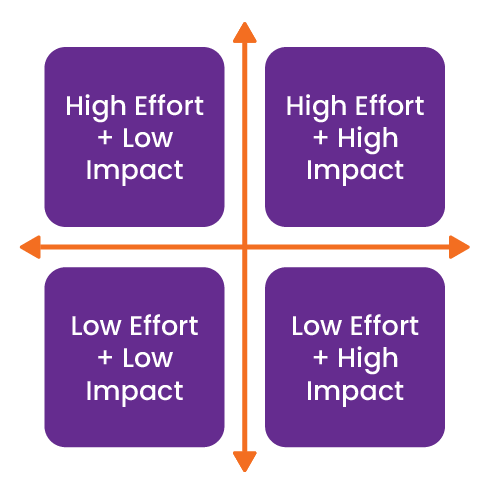Time-Smart B2B Social Media Strategy
A Practical Guide for Overextended
Marketing Teams

Introduction: Why Social Media Feels Broken for B2B Marketers

You’re juggling a dozen priorities. Your sales team wants leads. Your executives want visibility. And somewhere in the chaos, you’re also supposed to maintain a sparkling social presence across multiple platforms.
If that sounds exhausting, it’s because it is.
For most B2B marketers, the real challenge isn’t knowing social media matters — it’s finding the time and focus to do it well. That’s where the Time-Smart approach comes in: Less scatter, more strategy. Fewer posts, better results.

In this B2B social media strategy guide, we’ll walk you through how to:
- Identify the platforms that actually move the needle.
- Repurpose content like a pro.
- Make LinkedIn work harder for you.
- Automate without losing your voice.
- Measure what matters.
- Keep momentum without burning out.
By the end, you’ll have a clear, practical plan to make social media work for you — without it taking over your life.
Prefer to save this guide and read it later?

Table of Contents:

 Meet Dana:
Meet Dana:
Dana is the marketing director at a mid-sized software company. Like many overextended B2B marketers, she’s responsible for lead generation, brand awareness, internal reporting, sales support … and oh yes, keeping up with five different social media channels.
Her executive team says, “We need to be everywhere.” So Dana posts a webinar teaser on LinkedIn, tries to keep Facebook updated with press releases, shares blog posts on X, experiments with Instagram because a competitor is there, and struggles to get traction on YouTube.
By Friday, she’s exhausted — and despite all that effort, the only channel consistently bringing in leads is LinkedIn. The rest are draining her time without delivering meaningful results.
Sound familiar?
Why Spreading Yourself Thin Doesn’t Work
The pressure to “be everywhere” is one of the biggest myths in B2B marketing. While large consumer brands might thrive on TikTok, Instagram, and YouTube simultaneously, most B2B companies don’t have the audience — or the resources — to succeed on every platform.
The Time-Smart approach flips the script: Instead of trying to keep up with everything, you focus only on what matters. That means:
- Less scatter, more strategy.
- Fewer platforms, better performance.
- Energy spent where results actually come from.
How to Choose Your Focus Platforms
Look at your data.
Don’t just assume you need to be on every platform because your competitors are. Use your website analytics and social insights to track where your traffic, engagement, and leads are really coming from. For most B2B companies, LinkedIn is the clear winner, followed (sometimes) by YouTube or niche communities.
If you’re not sure, go to Google Analytics and check your referral traffic report. If Twitter sends you 12 visitors a month while LinkedIn sends 500, the choice is obvious.
Know your audience.
Where do your buyers spend time when they’re looking for professional insights? Chances are, it’s not TikTok. For most B2B industries, LinkedIn remains the go-to hub for networking and thought leadership. YouTube is powerful for education and tutorials. And X may still have pockets of influence in certain industries, but only if conversations there are truly relevant.
Be realistic.
Even if your audience occasionally uses Instagram or Facebook, can you realistically keep those channels active with quality content? If the answer is no, it’s better to have one strong, consistent channel than five mediocre ones.
The Effort vs. Impact Matrix
A simple tool can help you visualize this decision:
- High Effort + High Impact:
Worth doing if you can manage the workload (e.g., LinkedIn thought leadership, employee advocacy). - Low Effort + High Impact:
Absolute keepers (e.g., repurposing blog posts into LinkedIn snippets). - High Effort + Low Impact:
Cut immediately (e.g., spending hours editing YouTube videos that get 20 views). - Low Effort + Low Impact:
Optional; only maintain if it truly takes no time.

Plot each of your active channels on this grid. Chances are, one or two will clearly stand out as high impact, while the rest cluster in the “not worth it” zone.
How to Discuss Priorities with Your Executives
 Convincing leadership to let go of the “we need to be everywhere” mindset can be tough. Here’s how to frame it:
Convincing leadership to let go of the “we need to be everywhere” mindset can be tough. Here’s how to frame it:
- Show the numbers: “LinkedIn has generated 85% of our inbound leads. Facebook has generated zero.”
- Highlight opportunity cost: “If we redirect the five hours we spend on Facebook each week into LinkedIn, we can double our posting cadence and launch a monthly newsletter.”
- Frame it as focus, not abandonment: “We’re not giving up on social — we’re doubling down on where it actually works.”
🔄 Try This: Priority Reset Exercise:
- Make a list of every social platform you currently post on.
- For each one, note how much time it takes weekly and what results it produces (traffic, leads, engagement).
- Plot them on the Effort vs. Impact Matrix.
- Identify 1–2 “focus platforms” and set a 90-day plan to test what happens when you redirect effort there.

👉 By narrowing her focus to the platforms that actually delivered results, Dana finally stopped spinning her wheels and spreading herself too thin, and she is now making smarter, more intentional choices. This sets the stage for a social media strategy she can sustain.

 After an exhausting week of putting out marketing fires, Dana sits down to plan the next month’s content. She opens a blank spreadsheet, stares at the empty cells, and sighs. “How am I supposed to come up with something fresh to say on social media?” she wonders.
After an exhausting week of putting out marketing fires, Dana sits down to plan the next month’s content. She opens a blank spreadsheet, stares at the empty cells, and sighs. “How am I supposed to come up with something fresh to say on social media?” she wonders.This is where many B2B marketers feel stuck. The constant demand for new content is relentless. But you don’t need to reinvent the wheel every time. Instead, the Time-Smart approach encourages you to build once, use everywhere.
What Is the Time-Smart “Pillar-to-Post” Method?
 The idea is simple: Create one substantial piece of content (a pillar) and then repurpose it into many smaller, channel-appropriate pieces (the posts).
The idea is simple: Create one substantial piece of content (a pillar) and then repurpose it into many smaller, channel-appropriate pieces (the posts).
- Pillars are your big, anchor assets: webinars, research reports, case studies, or blog posts.
- Posts are the snackable spin-offs: LinkedIn updates, infographics, short videos, quote graphics, carousels, polls.
This way, instead of constantly chasing new ideas, you’re squeezing maximum value from the work you’ve already done.
Why Pillar-to-Post Works for B2B
Repurposing isn’t cutting corners — it’s being strategic. B2B buyers rarely consume content in a straight line. They may scroll LinkedIn on Monday, skim a newsletter on Wednesday, and download a whitepaper weeks later.
In this reality, each touchpoint needs to reinforce your message. And that’s the beauty of the Time-Smart approach. By breaking one core asset into multiple pieces, you:
- Stay consistent without overloading your team.
- Reach buyers on different platforms in the format they prefer.
- Extend the lifespan of your best ideas, rather than watching them fade after one blog post.
Example: Breaking Down a Blog Post
Dana writes a 2,000-word blog post about cybersecurity trends. Using pillar-to-post, here’s how she repurposes it:
- 3 LinkedIn text posts highlighting individual trends.
- 1 short video of her CTO giving a 90-second overview.
- 2 quote graphics pulling punchy stats from the post.
- 1 carousel summarizing “5 Key Takeaways” in slides.
- Newsletter snippet linking back to the full article.
- One poll question on LinkedIn to spark conversation.
Suddenly, one blog post becomes two weeks of social content.
Beyond Blogs: Other Repurposing Ideas
This approach works with every content format you’re already using:
- Webinars → Turn the recording into short video clips, a slide carousel, and a recap blog.
- Case Studies → Distill the story into a customer quote graphic, a “before vs. after” LinkedIn post, and a 2-minute testimonial video.
- Research Reports → Pull out key charts for LinkedIn, record a 5-minute summary video, and create a gated infographic as a mini-offer.
- Podcasts → Chop the episode into short audio snippets, quote cards, and highlight reels.
Adapting Tone for Each Channel
Dana knows that posting the same message everywhere doesn’t work. Repurposing isn’t copy-paste — it’s translation.
- LinkedIn → Conversational, professional, story-driven.
- YouTube → Educational, slightly more polished, with clear visuals.
- X → Concise, timely, snappy.
- Instagram → Highly visual, behind-the-scenes, culture-focused.
♻️ Try This: Repurposing Sprint:
- Choose one pillar piece you’ve already created (a blog, webinar, or case study).
- Brainstorm 5–7 derivative posts across your main channel(s).
- Schedule those out for the next two weeks.
- Track which formats resonate most — those are your repeatable winners.

👉 Dana is now taking advantage of the Time-Smart promise: It’s not about more content, it’s about smarter content. Dana gets her weekends back, and her audience actually sees her message multiple times instead of just once.


After getting smarter about her social media content creation, Dana finally feels like she can breathe.
But here’s the thing: Narrowing her focus only works if she squeezes every drop of value out of the platform that matters most. And in B2B, that platform is almost always LinkedIn.
LinkedIn isn’t just another social channel. It’s the world’s largest professional networking site, and for most B2B industries, it’s where decision-makers, influencers, and buyers actually spend their time. If you’re going to invest your limited energy anywhere, this is the place.
Why LinkedIn Deserves Your Attention
- Audience fit: More than 65 million decision-makers are active on LinkedIn. That means your buyers, partners, and even potential recruits are there.
- Trust factor: LinkedIn is seen as a credible, professional space. Content here carries more authority than the same message posted on Instagram or Facebook.
- Organic reach potential: Unlike some other platforms, LinkedIn’s algorithm still rewards engaging, human-centered content. You don’t have to pay to get noticed (though paid options can help).
- Multi-purpose use: It’s not just for posting. You can use LinkedIn for lead generation, recruiting, networking, social listening, and thought leadership.
For Dana, LinkedIn is no longer just another platform on her list. It’s the engine of her B2B marketing strategy.
Four Ways to Make LinkedIn Work Harder
1. Optimize Your Company Page
Think of your LinkedIn company page as a digital storefront. Too often, B2B marketers treat it like a placeholder, when it should be an engine for discovery and conversion.- Write a compelling “About” section with clear messaging and target keywords.
- Keep your services updated and easy to skim.
- Use visuals (banners, logos) that reflect your brand personality.
- Post regularly so the page looks active and credible.
2. Post Conversation-Starters
LinkedIn’s algorithm rewards posts that spark genuine interaction. That means likes aren’t enough — you want comments, shares, and discussions.
- Share industry takes (“What trend do you think is overhyped?”).
- Run polls with thoughtful questions.
- Share short stories or personal insights tied to professional lessons.
- Ask your audience to weigh in on challenges you know they face.
Dana experimented with posting her blog recaps as open-ended questions, and she quickly noticed engagement rising. Instead of broadcasting, she’s starting conversations.
3. Empower Employee Thought Leadership
People connect with people more than they connect with logos. That’s why employee posts often outperform company posts. Encourage your colleagues — executives, SMEs, sales reps — to share company content in their own voices.
- Provide easy-to-share snippets or graphics.
- Host a “lunch and learn” on how to build a personal brand on LinkedIn.
- Recognize and celebrate employees who engage actively.
The result? Broader reach, authentic voices, and a stronger reputation for your brand.
4. Experiment with LinkedIn Newsletters
LinkedIn newsletters can be powerful for nurturing subscribers directly within the platform.
- Repurpose blog content into serialized newsletters.
- Invite your company’s followers to subscribe.
- Keep the tone personal and practical.
- Use visuals and formatting for easy reading.
Dana tests a monthly LinkedIn newsletter based on her blog content. Within three months, she has hundreds of subscribers and a new direct channel to her audience — all without additional work.
🌟 Bonus Tip: Don’t Forget LinkedIn Ads
If budget allows, LinkedIn’s paid campaigns can target your exact audience by job title, industry, or company size. Sponsored content and InMail can amplify your best-performing posts and get them in front of more of the right people. Start small, test carefully, and expand only when you see results.
⚡ Try This: LinkedIn Power-Up Checklist:
- Audit your company page for clarity and keywords.
- Identify one executive or subject matter expert to spotlight with thought leadership posts.
- Draft three “conversation-starter” posts for the next two weeks.
- Test one poll or one LinkedIn newsletter to expand reach.

👉 With a focused LinkedIn strategy, Dana isn’t just checking the social media box anymore — she’s building relationships, authority, and trust where it matters most.


Now that Dana has streamlined her social platforms and doubled down on LinkedIn, she’s finally posting content that resonates. But she still feels chained to her keyboard. Every time she wants to publish, she has to stop what she’s doing, log in, and manually post.
Worse, if she’s out of office, the feed goes silent.
That’s when Dana realizes she needs automation — but the right kind.
Why Automation Matters (and Why It Gets a Bad Rap)
Automation is a lifesaver for busy B2B teams. Scheduling tools let you plan ahead, free up brain space, and maintain consistency without constantly context-switching. But automation has a reputation problem: Too many brands abuse it. They “set and forget” their posts, ignore comments, or churn out templated updates that feel robotic.
The Time-Smart approach to automation is about balance: Use tools to handle the repetitive tasks, but keep space for authentic, real-time interaction.
Smart Automation Rules
1. Batch Your Work
Set aside one or two blocks of time each month to create and schedule posts in advance. This frees you from daily posting stress and helps ensure you’re balancing content types (thought leadership, event promos, repurposed blog snippets, etc.)
2. Leave Room for Timely Posts
Not everything should be pre-scheduled. Industry news, trending conversations, or big company wins need to be posted in the moment. Build flexibility into your plan so you can respond quickly when something relevant happens.
3. Use Alerts for Engagement
Automation isn’t just for posting. Set up alerts for comments, direct messages, and mentions. Tools like HubSpot, Buffer, or Hootsuite can ping you when it’s time to jump in and engage. This way, you never miss the conversations that matter.
4. Repurpose Automatically
Many tools now allow you to create “content queues” that recycle evergreen posts on a schedule. This works well for assets like blog highlights, customer testimonials, or case study snippets. But be careful: Avoid recycling time-sensitive content (like event promos or product launches), or you risk embarrassing repeats.
Dana’s Automation Toolkit
Dana decides to set up a simple production process in HubSpot:
- She creates and schedules all of her posts at the start of each month.
- She blocks 15 minutes each morning to check engagement notifications.
- She saves evergreen posts (like customer testimonials) in a queue that automatically reposts them every few months.
- She keeps a shared spreadsheet where sales and product managers can drop content ideas that she can schedule later.
The result? Her LinkedIn feed feels steady and consistent — but not robotic.
Avoiding Common Pitfalls
Be mindful of these easy-to-make mistakes when setting up your social media automation strategy:
- Overposting. Just because you can schedule three posts a day doesn’t mean you should. Flooding the feed often leads to lower engagement.
- Ignoring comments. Automation doesn’t excuse silence. Social media is social — you need to respond.
- Over-automating personal accounts. Your company page can be highly scheduled, but your CEO’s personal page should always feel authentic.
- Audit your current posting process. How much is manual vs. automated?
- Choose one scheduling tool: HubSpot, Buffer, Hootsuite, or Sprout Social.
- Commit to a two-week experiment: Batch-schedule posts in advance and block daily time for live engagement. Track how much time you save and whether engagement improves.

👉 By embracing the right kind of automation, Dana can finally take a day off without her company’s social feed going dark. Automation handles the mechanics, while she stays focused on the human connections that really move the needle.


Dana has made big progress: She’s narrowed her focus, mastered repurposing, leaned into LinkedIn, and automated her posting. But her executives still ask the dreaded question:
“So … what’s all this social media effort actually doing for us?”
It’s a fair question. And here’s the trap: It’s tempting to answer with vanity metrics like followers or impressions. They’re easy to measure, they look impressive in a slide deck, and they give the illusion of progress. But in B2B, vanity metrics don’t tell the real story.
The Time-Smart approach means focusing only on the metrics that directly connect to business impact.
Why Social Media Vanity Metrics Mislead
Dana realizes she’s spending hours reporting on numbers her leadership team doesn’t care about.
- Follower counts don’t matter if your audience isn’t engaging or converting.
- Impressions may be inflated by people outside your target market.
- Likes feel good, but they rarely correlate with pipeline.
But when she shifts her focus to smarter reporting, she starts saving time and earning credibility by showing how social is driving real business outcomes.
Social Media Metrics That Actually Matter
1. Engagement Rate
- Engagement shows how much your content resonates. Track comments, shares, and clicks relative to reach.
2. Click-Through Rate (CTR)
- How many people are leaving LinkedIn (or another platform) to visit your website or landing page?
- CTR proves that social is moving your audience deeper into your funnel.
3. Leads Generated
- The ultimate measure for most B2B marketers. Track how many leads (form fills, demo requests, ebook downloads) originated from social campaigns.
- This often requires integrating your CRM with your social and website analytics.
4. Content Insights
- Which topics consistently perform best?
- Which formats (polls, videos, carousels) get the most traction?
- Which posting times generate the most engagement?
These insights help you double down on what’s working and stop wasting time on what isn’t.
Creating a Time-Smart Social Media Reporting Process
Dana doesn’t have the bandwidth to build 20-slide social reports every month. Instead, she creates a 15-minute reporting habit:
- At the start of each month, she pulls data from LinkedIn Analytics and Google Analytics.
- She logs three key numbers: engagement rate, CTR, and leads generated.
- She adds quick notes on which posts/topics performed best.
- She looks at the trend line compared to the previous month: improving, holding steady, or declining.
The whole process takes less than a coffee break.
🌟 Bonus: Sharing Results Internally
One mistake many marketers make is keeping social results to themselves. When Dana started sharing her short reports with her sales and leadership teams, she gained:
- Trust from executives, who saw proof of ROI.
- Buy-in from sales, who started to see social media as a real pipeline driver.
- Momentum for future experiments, because her team felt confident in what was working.
- Create a simple spreadsheet with four columns: Date, Engagement Rate, CTR, Leads.
- Once a month, fill in the numbers from your analytics dashboards.
- Add 2–3 notes: top-performing post, lowest-performing post, biggest surprise.
- Share the snapshot with your boss, sales team, or execs.

👉 For Dana, reporting used to feel like busywork. Now, it’s a streamlined process that shows real impact — and positions her as a strategic marketer who knows how to connect social media back to business results.


Six months into her new Time-Smart approach, Dana feels like a different marketer. Her LinkedIn presence is consistent, her posts are engaging, and her reports actually mean something to leadership.
But she’s also learned something important: Consistency isn’t about heroic effort. It’s about building systems that prevent burnout.
Why Momentum Matters in Social Media
Social media marketing isn’t a one-and-done project. It’s an ongoing commitment. And without the right habits, even the best strategy can fizzle out. The more consistently you show up:
- The more trust you build with your audience.
- The more data you gather to refine your strategy.
- The more visible your brand becomes in industry conversations.
But here’s the catch: Inconsistency can undo all that progress. One month of silence can feel like you’ve gone back to square one. Dana knows she needs guardrails to keep things steady, even during busy seasons.
Three Social Media Habits That Keep You Going
1. Batch Content Creation
Instead of scrambling for ideas every morning, Dana starts dedicating one Friday each month to content creation. She brainstorms, drafts, and schedules as many posts as possible in one focused session.
2. Maintain a Content Bank
A content bank is a library of evergreen posts, graphics, and ideas you can pull from when things get hectic. Dana keeps hers in a shared spreadsheet with tabs for:- Blog snippets
- Customer quotes/testimonials
- FAQs from sales
- Industry stats and insights
- Employee spotlights
When her week goes sideways, she can grab a ready-made post from the bank and keep the feed active without reinventing the wheel.
3. Rotate Themes to Simplify Brainstorming
Instead of starting with a blank page, Dana rotates through content “themes” each week:
- Week 1: Thought leadership (industry trends, hot takes)
- Week 2: Customer stories or testimonials
- Week 3: Educational content (how-to posts, frameworks)
- Week 4: Culture or behind-the-scenes highlights
This rhythm gives her structure while keeping her content diverse.
When to Consider Outsourcing
Even with batching and content banks, some teams still find social media marketing to be overwhelming. If you’re spending too much time on mechanics (e.g., designing graphics, scheduling posts, etc.), outsourcing your social media marketing to a trusted agency can be a smart move.
Outsourcing doesn’t mean losing your voice. It means freeing up your time to focus on strategy, engagement, and leadership alignment — the parts only you can do.
Dana realizes she didn’t need to design every graphic herself. By outsourcing key aspects of her strategy to her marketing agency, she cuts her workload in half while actually improving content quality.
- Block one recurring day each month for batching posts.
- Build a content bank in a spreadsheet or project management tool.
- Choose 3–4 rotating themes to make brainstorming easier.
- Decide which tasks (if any) could be outsourced for efficiency.

👉 With these habits in place, Dana’s social strategy no longer feels like a sprint from deadline to deadline. It’s a steady, sustainable marathon — one that keeps her brand visible, her audience engaged, and her workload under control.

When Dana first started, she was overwhelmed. She was juggling too many platforms, scrambling for new content, and constantly defending social media’s value to her executives.
But by taking a Time-Smart approach, she transformed her social strategy:
- She cut unnecessary platforms and focused on what really moved the needle.
- She repurposed her best content instead of reinventing the wheel.
- She leaned into LinkedIn, where her buyers were already spending time.
- She used automation to stay consistent without feeling robotic.
- She measured results in a way that actually mattered to the business.
- She built systems and habits to keep the momentum going without burning out.
The result? Social media marketing stopped feeling like busywork and became a genuine driver of brand awareness, engagement, and leads.
And here’s the best part: You can do this too.
You don’t need to be everywhere. You don’t need to post every day. You don’t need a huge team or endless resources. What you need is focus, efficiency, and a plan that works with your schedule instead of against it.
Your Next Step
 If you’re ready to see how the Time-Smart approach could work for your team, let’s make it practical. Book a free 15-minute social audit call with us.
If you’re ready to see how the Time-Smart approach could work for your team, let’s make it practical. Book a free 15-minute social audit call with us.
In just 15 minutes, we’ll:
- Review your current social channels.
- Identify quick wins you can act on immediately.
- Show you how to focus your efforts where they’ll have the biggest impact.
No fluff, no pressure — just clear, actionable insights you can use to make social media simpler and more effective.





